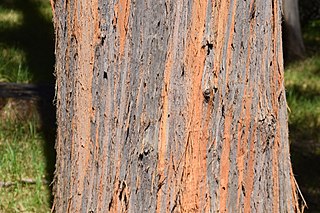
Eucalyptus marginata, commonly known as jarrah, djarraly in Noongar language and historically as Swan River mahogany, is a plant in the myrtle family, Myrtaceae and is endemic to the south-west of Western Australia. It is a tree with rough, fibrous bark, leaves with a distinct midvein, white flowers and relatively large, more or less spherical fruit. Its hard, dense timber is insect resistant although the tree is susceptible to dieback. The timber has been utilised for cabinet-making, flooring and railway sleepers.

Deua is a national park located in New South Wales, Australia, 320 kilometres (200 mi) south of Sydney, and 100 kilometres (62 mi) east of Canberra. The nearest towns on the coast are Batemans Bay, Moruya and Narooma.

Yarra Ranges National Park is located in the southeastern region of Australia, in the Victoria Central Highlands, 107 kilometres northeast of Melbourne. Established in 1995 and managed by the statutory authority Parks Victoria, the carbon-rich forest is home to the majestic Mountain Ash Tree, one of the tallest tree species in the world. A wide diversity of fauna make their home across the park's 76,003 hectares, including kangaroos, wallabies, wombats, platypi and 120 species of native birds. The Yarra, O'Shaunessy and Taggerty Rivers flow through the Park, and with several reservoirs form an important source of drinking water for the City of Melbourne. Among the conservation challenges facing Yarra Ranges National Park are climate change and invasive species of weeds.

Pulpwood refers to timber with the principal use of making wood pulp for paper production.

Belgrave Heights is a town in Melbourne, Victoria, Australia, 38 km south-east from Melbourne's central business district. Its local government area is the Shire of Yarra Ranges. At the 2016 census, Belgrave Heights had a population of 1,360.

The Black Friday bushfires of 13 January 1939, in Victoria, Australia, were among the worst natural bushfires (wildfires) in the world. Almost 20,000 km² of land was burned, 71 people died, several towns were entirely obliterated and the Royal Commission that resulted from it led to major changes in forest management. Over 1,300 homes and 69 sawmills were burned, and 3,700 buildings were destroyed. It was calculated that three-quarters of the State of Victoria was directly or indirectly affected by the disaster. The Royal Commission noted that "it appeared the whole State was alight on Friday, 13 January 1939".

Eucalyptus diversicolor, commonly known as the karri, is a eucalypt native to the wetter regions of southwestern Western Australia.

Eucalyptus globulus, known as the Tasmanian bluegum or Southern blue gum, is an evergreen tree, one of the most widely cultivated trees native to Australia. They typically grow from 30–55 m (98–180 ft) tall. The tallest currently known specimen in Tasmania is 90.7 m (298 ft) tall. There are historical claims of even taller trees, the tallest being 101 m (331 ft). The natural distribution of the species includes Tasmania and southern Victoria. There are also isolated occurrences on King Island and Flinders Island in Bass Strait and on the summit of the You Yangs near Geelong.
Eucalyptus oil is the generic name for distilled oil from the leaf of Eucalyptus, a genus of the plant family Myrtaceae native to Australia and cultivated worldwide. Eucalyptus oil has a history of wide application, as a pharmaceutical, antiseptic, repellent, flavouring, fragrance and industrial uses. The leaves of selected Eucalyptus species are steam distilled to extract eucalyptus oil.

Eucalyptus obliqua, commonly known as the brown top, brown top stringbark, messmate, messmate stringybark, stringybark or Tasmanian oak, is a hardwood tree native to south-eastern Australia.
Tasmanian oak refers to the hardwood produced by three trees: Eucalyptus regnans, Eucalyptus obliqua or Eucalyptus delegatensis, when it is sourced from the Australian state of Tasmania.
Despite the common name 'oak', none of the species are in the genus Quercus.

Mallee is the growth habit of certain eucalypt species that grow with multiple stems springing from an underground lignotuber, usually to a height of no more than 10 m (33 ft). It is most common in plants of the genus Eucalyptus, many of which naturally grow in a mallee habit, and some of which grow as single-stemmed trees initially, but recover in mallee form if burnt to the ground by bushfire. It also occurs in the closely related genera Corymbia and Angophora. The word "mallee" may also be used as a noun in reference to species or individual plants with a mallee habit.

Eucalyptus oreades, commonly known as the Blue Mountains ash, is a species of eucalyptus native to eastern Australia.

Mount Banda Banda, a mountain of the Mid North Coast region of New South Wales, Australia, is situated 320 kilometres (200 mi) from Sydney within the Willi Willi National Park. Banda Banda can be seen on the south western horizon, 39km from the town of Kempsey. At 1,258 metres (4,127 ft) AHD it is the highest mountain in the region.

Eucalyptus sieberi, the silvertop ash or black ash, is a common eucalyptus tree of south eastern Australia. The range of distribution is in the higher rainfall areas, from near sea level to high altitude. Growing on shallow soils of medium to low fertility, south from Morisset, New South Wales to Victoria and Tasmania.














